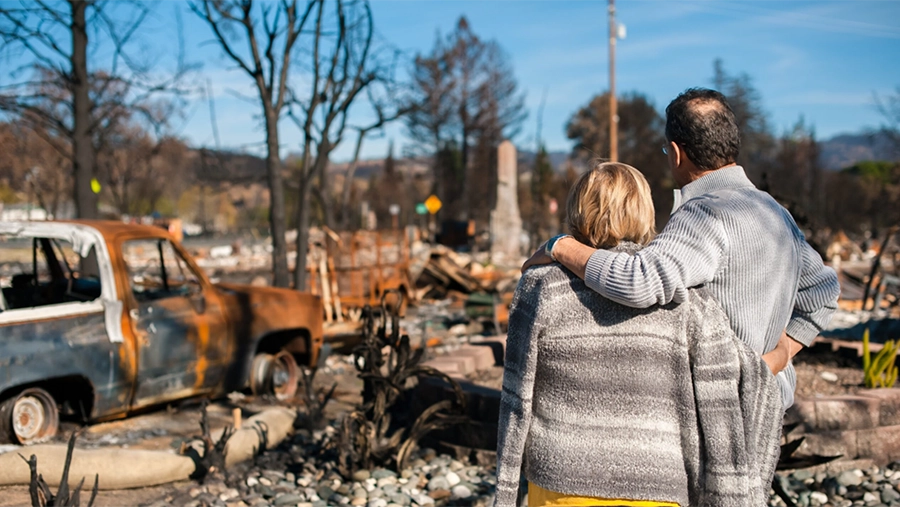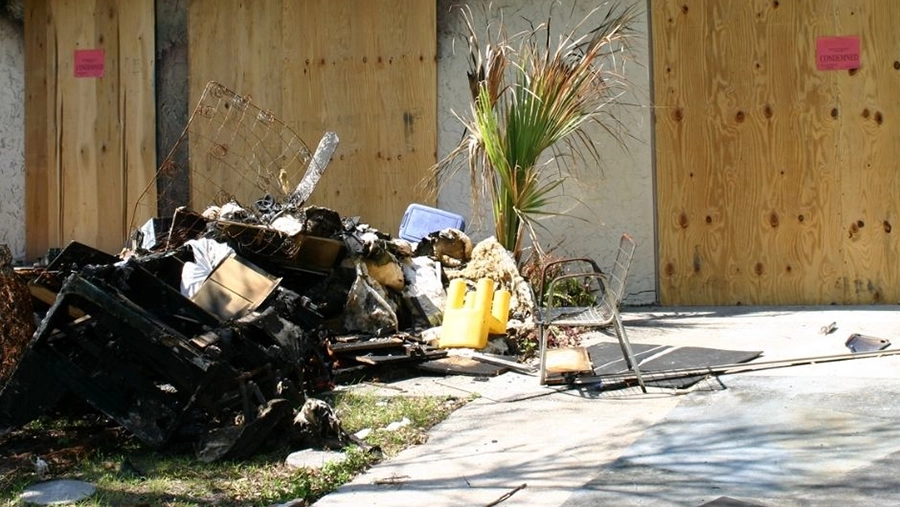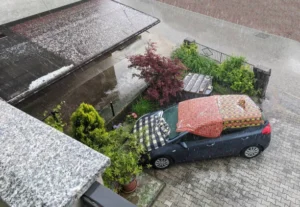When the flames are out and the smoke clears, you’re left with more than just charred memories. Debris. Ash. Toxic remnants of a fire that tore through your space. And now, you’re wondering: How much is this going to cost me to clean up? You’re not alone. At TX Public Adjusting, we’ve helped countless homeowners across Houston and the entire state of Texas navigate the tricky, expensive, and sometimes overwhelming process and cost of house fire debris removal. Here’s the good news: with the right info, smart steps, and the right team behind you, you can make this part of the recovery journey a whole lot easier.
Let’s break it down.
What Is House Fire Debris Removal?
House fire debris removal is far more involved than simply hauling away charred wood and sweeping up ashes. It’s a specialized, comprehensive process that includes clearing out everything from burned building materials and destroyed furniture to layers of soot, ash, and waterlogged contents. In many cases, it also means addressing hazardous materials, like asbestos, lead paint, or chemicals released by burned plastics, that pose serious health risks.
The job demands protective equipment, proper containment, and licensed waste disposal. This phase must happen before any rebuilding or restoration can begin, making it a crucial first step toward recovery. If left untreated, lingering debris can compromise structural integrity, promote mold growth from firefighting water, and endanger indoor air quality. In short, fire debris removal isn’t just about cleanup, it’s about restoring safety and preparing your home for what comes next.
Average House Fire Debris Removal Cost in Texas
So, what’s the bottom line? In Texas, house fire debris removal cost typically ranges from $2,000 to over $15,000, but that’s just the starting point. For minor fires, like a contained kitchen fire, you might expect to pay between $2,000 and $5,000. If the fire spreads to multiple rooms or floors, removal costs can escalate quickly to $10,000 to $30,000. In cases where the entire home is damaged and requires full demolition and cleanup, expenses can exceed $50,000, especially if heavy equipment or hazardous waste removal is involved.
These costs cover debris cleanup only and don’t include structural restoration, repairs, or rebuilding. Every fire scenario is different, so prices depend on fire severity, square footage, materials burned, and the presence of harmful substances like asbestos. Understanding these ranges helps homeowners in Houston and across Texas plan more effectively for recovery.
Key Factors That Affect House Fire Debris Removal Cost
Not every fire leaves the same footprint. That’s why cleanup costs can vary dramatically. Here’s what influences the price:
1. Size of the Fire
The overall size of the fire plays a major role in determining debris removal costs. A small, contained kitchen fire might cost between $1,000 and $5,000 to clean up. However, if the fire damages multiple rooms, an entire floor, or spreads throughout the home, debris removal expenses can quickly rise to $10,000–$30,000 or more. Full demolitions due to total structural loss may even push the cost beyond $50,000. More fire means more damage, more waste, and more labor, making the size of the blaze a key cost factor in post-fire cleanup.
2. Extent of Structural Damage
When a fire severely damages the structure of your home, like the foundation, roof, or load-bearing walls, debris removal becomes far more complex and costly. This level of destruction often requires specialized equipment, skilled labor, and more time on-site to ensure safe and complete removal. Additionally, structural instability can pose safety risks, which may necessitate extra precautions and permits. These factors can significantly drive up the total cost. In major fire events, cleanup from extensive structural damage can push debris removal costs well beyond $30,000, especially if full demolition is needed before rebuilding can begin.
3. Presence of Hazardous Materials
Older homes in Houston and throughout Texas may contain dangerous materials like asbestos, lead-based paint, or other toxic substances. When a fire damages or disturbs these materials, cleanup becomes much more complicated. State and federal regulations require licensed hazardous waste removal specialists to handle the job safely. This means additional testing, containment, protective gear, and specialized disposal methods. The presence of these hazardous materials can add $3,000 to $10,000 or more to your overall debris removal costs, depending on the type and extent of contamination. Ignoring proper removal can pose serious health risks and delay your restoration timeline.
4. Materials Burned
The type of materials destroyed in the fire directly affects your debris removal costs. Fires that burn synthetic items, like plastics, foam insulation, vinyl flooring, or electronics, release hazardous chemicals and toxic residues, requiring specialized handling and disposal procedures. These materials often need to be transported to regulated facilities, adding both time and expense. In contrast, debris from natural materials such as wood, drywall, and fabric tends to be less costly to remove and dispose of. If your home contained a high volume of synthetics, expect to pay significantly more for safe, compliant removal, especially if environmental regulations apply.
5. Property Accessibility
The location of the fire-damaged area plays a significant role in determining debris removal costs. If the debris is in hard-to-access spaces such as attics, crawl spaces, basements, or tight corners of multi-story homes, cleanup becomes more labor-intensive. Crews may need to use specialized equipment or spend additional time dismantling structures to reach and safely remove all materials. This increased effort translates into higher labor costs and extended project timelines. Limited accessibility can also increase risks for workers, requiring added safety measures. All of these factors can push overall debris removal expenses substantially higher than in more open, accessible areas.
How Insurance Helps With Debris Removal Costs
Here’s the silver lining: most homeowner’s insurance policies in Texas do include coverage for fire debris removal, but that coverage often comes with limits. Typically, your policy will cap debris removal coverage at 5% to 10% of the total claim amount. For example, if your fire damage claim totals $80,000, your insurance might only reimburse you up to $8,000 for debris removal. In some cases, additional debris removal coverage may be available through optional policy riders or endorsements, but these usually require an added premium and must be in place before disaster strikes.

At TX Public Adjusting, we work on your behalf, not the insurance company’s, to dig deep into your policy, interpret the fine print, and fight for the maximum reimbursement you’re entitled to. We’ve seen too many homeowners across Houston and greater Texas lose out simply because they weren’t aware of what their policies actually cover. Debris removal is an essential part of fire recovery, and we make sure it doesn’t become an out-of-pocket burden you weren’t prepared for.
Realistic Cost Breakdown
Understanding what goes into house fire debris removal cost can help you prepare for the real financial impact. It’s not a flat fee, it’s a layered process involving multiple cost components, each influenced by the severity of the fire and specific site conditions.
- Labor: Expect to pay $50 to $150 per hour per worker, depending on expertise, certifications, and location within Texas. Larger or more hazardous jobs require more crew members and hours.
- Equipment Use: Specialized equipment like loaders, dumpsters, and protective gear can add $500 to $5,000+, especially if the job requires full demolition or cleanup in tight spaces.
- Hazardous Material Testing & Disposal: If the fire affected asbestos, lead paint, or chemicals, testing and regulated disposal can cost anywhere from $500 to $20,000, depending on the volume and severity.
- Hauling and Dumping Fees: Getting the debris off your property and into an approved landfill or facility can cost between $1,000 and $3,000, depending on how much waste was generated.
This isn’t your average cleanup. Fire debris removal is highly regulated, physically intensive, and must be done safely and systematically to avoid health and environmental risks.
The Debris Removal Process: What to Expect
While every fire-damaged home presents unique challenges, the debris removal process generally follows a structured and regulated path to ensure safety, compliance, and efficiency.
- Initial Inspection – A licensed professional thoroughly inspects the site to assess the extent of the fire damage. They identify materials that require specialized handling, such as asbestos or lead-based debris.
- Documentation – Before anything is removed, it’s essential to take detailed photographs of all fire-damaged areas and items. This visual evidence supports your insurance claim and helps ensure you’re fully compensated.
- Safety Setup – Crews arrive wearing proper protective equipment and set up safety zones and containment areas to control hazardous particles and reduce exposure.
- Debris Sorting & Removal – All affected materials, including charred building elements, damaged furniture, and compromised structures, are carefully sorted, logged, and removed.
- Disposal – Non-hazardous debris is taken to local disposal sites, while hazardous waste is handled per federal and Texas environmental regulations and delivered to approved facilities.
Depending on the size and complexity of the damage, the entire process may take anywhere from a few days to several weeks, especially when hazardous material abatement or full structural demolition is required.
Homeowner Responsibilities After a Fire
There’s no sugarcoating it, after a house fire, you are responsible for taking immediate action to mitigate further damage. Your insurance company requires you to act quickly and reasonably to prevent additional harm. That means securing the property, stopping further deterioration, and hiring professional contractors or a fire restoration company to start the debris removal process as soon as it’s safe.
Equally important is documentation. Take clear, detailed photos of everything: scorched walls, soot-covered furniture, fire hose water damage, busted doors, broken windows, and even rooms that look untouched but may have hidden smoke residue. This visual proof strengthens your claim and ensures you’re compensated for the full extent of your loss.
Delaying action or failing to document properly could reduce your insurance payout. That’s why acting fast, staying organized, and keeping records is crucial in the first few days following a fire.
Should You Restore or Rebuild?
Here’s the big decision: is it better to remove the debris and restore, or tear down and start fresh?
Let’s look at an example:
- Restoration + cleanup after a kitchen fire: $16,000 to $20,000
- Total kitchen remodel: $14,600 to $41,300
If your structure is still sound, restoration is almost always cheaper. But if foundational elements are damaged, rebuilding might be safer and more cost-effective long term.
Our team at TX Public Adjusting can help you assess both routes and negotiate with your insurer to support the best option.
How to Reduce Debris Removal and Fire Restoration Costs
The best way to cut debris removal and fire restoration costs is through smart prevention. Start with essentials:
- Install smoke alarms and sprinkler systems – Early detection and suppression can prevent a small fire from turning into a total loss.
- Schedule annual electrical inspections – Many fires in Texas begin with outdated or faulty wiring. A licensed electrician can catch these hazards early.
- Create and practice a fire escape plan – Quick, organized responses minimize confusion and can limit the spread of damage.
If disaster strikes, don’t go it alone. Working with a licensed public adjuster like TX Public Adjusting ensures you understand your policy and secure the maximum possible claim value. We help homeowners across Texas avoid costly mistakes and take back control of the recovery process.

Choosing the Right Contractor for Debris Removal
Not all cleanup crews are created equal. When hiring a professional, look for:
- State licensing and insurance
- Experience with fire damage specifically
- Clear cost estimates and contracts
- References from past clients
- Willingness to coordinate with your insurance provider
If you’re in Houston or anywhere in Texas, TX Public Adjusting can connect you with vetted fire restoration contractors we trust.
FAQs: House Fire Debris Removal Cost in Texas
Yes, most policies cover it, but usually up to 5–10% of your total claim amount.
Costs typically range from $2,000 to over $15,000, depending on the fire’s severity and damage.
Key factors include fire size, structural damage, hazardous materials, materials burned, and property accessibility.
Anywhere from a few days to several weeks, depending on the extent of the damage and type of cleanup.
Not always, removing asbestos, lead paint, or chemicals may cost extra and require certified teams.
It’s not recommended. It’s dangerous, and improper removal can void insurance coverage or lead to health risks.
Start as soon as the fire department says it’s safe. The sooner you act, the better your insurance outcome.
Take clear photos of all fire, smoke, water, and structural damage, including items firefighters may have damaged during response.
Final Thoughts
Debris removal after a house fire isn’t something you can ignore, or handle lightly. It’s the first step toward reclaiming your home, your health, and your peace of mind. While the house fire debris removal cost/s can be steep, knowing what to expect, and having the right support team, can make the process far more manageable.
At TX Public Adjusting, we help Texas homeowners fight for the full value of their claims. We don’t work for the insurance companies, we work for you. From policy reviews to contractor recommendations, we’re here to take the weight off your shoulders.
Fire left a mess? Let’s clean it up the right way, together.







